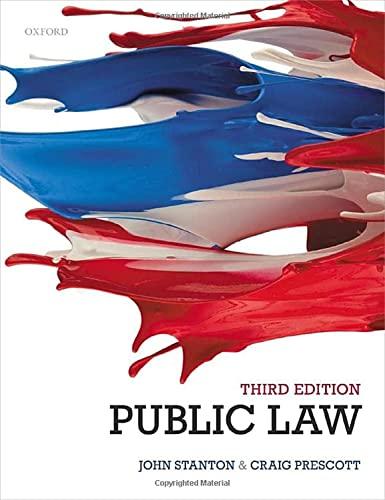Question
Case Issue and Factual Summary The case of Celotex Corp. v. Catrett went all the way to the United States Supreme Court. The matter started
Case Issue and Factual Summary The case of Celotex Corp. v. Catrett went all the way to the United States Supreme Court. The matter started when the plaintiff brought a wrongful death action alleging that her husband died as a result of exposure to asbestos products that were manufactured and distributed by the defendants. The defendant brought a motion for summary judgment, claiming that the plaintiff did not produce any evidence in discovery to show that the plaintiff's husband had been exposed to the defendant's products. The plaintiff opposed the motion by producing documents showing exposure, but the defendant argued that the documents were not admissible in court and therefore could not be considered. The trial court granted the motion and dismissed the action, but the Court of Appeals reversed, saying that there could be no summary judgment in favor of the defendant because of the defendant's failure to support its motion with proper evidence to show that there was no exposure. The issue was whether under Rule 56 summary judgment for the defendant was appropriate where the plaintiff had the burden of proof on a claim and failed to make a sufficient showing to establish an element of the claim. Celotex v. Corp. v. Catrett 477 U.S. 317 (1986) The United States District Court for the District of Columbia granted the motion of petitioner Celotex Corporation for summary judgment against respondent Catrett because the latter was unable to produce evidence in support of her allegation in her wrongful death complaint that the decedent had been exposed to petitioner's asbestos products. A divided panel of the Court of Appeals for the District of Columbia Circuit reversed, however, holding that petitioner's failure to support its motion with evidence tending to negate such exposure precluded the entry of summary judgment in its favor. We think that the position taken by the majority of the Court of Appeals is inconsistent with the standard for summary judgment set forth in Rule 56(c) of the Federal Rules of Civil Procedure. [Footnote 4] Under Rule 56(c), summary judgment is proper if the pleadings, depositions, answers to interrogatories, and admissions on file, together with the affidavits, if any, show that there is no genuine issue as to any material fact and that the moving party is entitled to a judgment as a matter of law. In our view, the plain language of Rule 56(c) mandates the entry of summary judgment, after adequate time for discovery and upon motion, against a party who fails to make a showing sufficient to establish the existence of an element essential to that party's case, and on which that party will bear the burden of proof at trial. In such a situation, there can be "no genuine issue as to any material fact," since a complete failure of proof concerning an essential element of the nonmoving party's case necessarily renders all other facts immaterial. The moving party is "entitled to a judgment as a matter of law" because the nonmoving party has failed to make a sufficient showing on an essential element of her case with respect to which she has the burden of proof. "[T]h[e] standard [for granting summary judgment] mirrors the standard for a directed verdict under Federal Rule of Civil Procedure 50(a). ..." Anderson v. Liberty Lobby, Inc., ante at 477 U.S. 250.
Of course, a party seeking summary judgment always bears the initial responsibility of informing the district court of the basis for its motion, and identifying those portions of "the pleadings, depositions, answers to interrogatories, and admissions on file, together with the affidavits, if any," which it believes demonstrate the absence of a genuine issue of material fact. But unlike the Court of Appeals, we find no express or implied requirement in Rule 56 that the moving party support its motion with affidavits or other similar materials negating the opponent's claim. The Federal Rules of Civil Procedure have for almost 50 years authorized motions for summary judgment upon proper showings of the lack of a genuine, triable issue of material fact. Summary judgment procedure is properly regarded not as a disfavored procedural shortcut, but rather as an integral part of the Federal Rules as a whole, which are designed "to secure the just, speedy and inexpensive determination of every action." Fed. Rule Civ. Proc. l. Rule 56 must be construed with due regard not only for the rights of persons asserting claims and defenses that are adequately based in fact to have those claims and defenses tried to a jury, but also for the rights of persons opposing such claims and defenses to demonstrate in the manner provided by the Rule, prior to trial, that the claims and defenses have no factual basis. The judgment of the Court of Appeals is accordingly reversed, and the case is remanded for further proceedings consistent with this opinion.
Questions for Discussion 1.Why did the Court of Appeals believe that the motion for summary judgment should be denied? 2.What are some of the policy reasons why the Court reverses the decision? 3.What could the plaintiff have done differently to avoid this result?
Step by Step Solution
There are 3 Steps involved in it
Step: 1

Get Instant Access to Expert-Tailored Solutions
See step-by-step solutions with expert insights and AI powered tools for academic success
Step: 2

Step: 3

Ace Your Homework with AI
Get the answers you need in no time with our AI-driven, step-by-step assistance
Get Started


